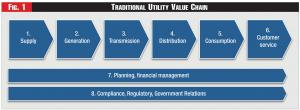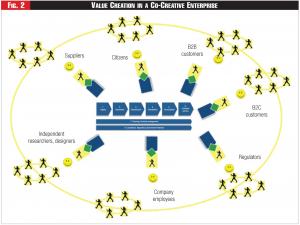Utilities have long lived in a closed, asset-centric world. Success historically has involved mastering the key value chain steps of generation, transmission, and distribution, developing good relationships with regulators to negotiate favorable rate structures, and providing a good-enough level of service to the customer (see Figure 1).

Success in the “new world” of utilities lies in the ability to engage communities of stakeholders in new ways, partnering with them to build an open ecosystem where assets in the ground are less important than the interactions that bind them together and the new experiences that they allow for all parties involved. This requires putting in place a new process of engagement and a new infrastructure allowing all stakeholders (utility management, utility employees, B2B and B2C customers, suppliers, regulators) to interact with each other in new and different ways. The future of utilities lies in becoming co-creative enterprises (see Figure 2).
Three Paths to Co-Creation
While there are a multitude of ways that enterprise co-creation can evolve, here are three tangible ways for utilities to start the co-creative journey.
1) New Communities of Interest: Utilities historically have subscribed to the notion that their primary function is the safe and reliable delivery of energy to customers – which certainly is paramount – but that their interaction ends at the meter. Yet from the customer’s perspective, that’s where their utility experience begins. More and more, companies are finding that it’s in customers’ interactions with their product or service where experiences occur and new value is created.
 Figure 1 - Traditional Utility Value Chain
Figure 1 - Traditional Utility Value Chain
Consider the case of a top running shoe manufacturer. This company had been providing a quality product for years, but about a decade ago came to the realization that the shoe itself was only one small part of the running experience.
To get more involved in the overall experience, the company developed and deployed an on-line engagement platform where communities of runners can share running data, event information, route maps, and even thoughts on related interests like music. The platform also allows runners to connect their running experience to other runners, coaches, professionals, friends, and family members. In other words, the company created a community, in which a set of stakeholders could co-create value though shared experiences. In the end, all stakeholders benefitted from the new value created.
What’s preventing a utility from creating a similar platform that allows end users to co-create value by sharing information on their own beyond-the-meter experiences around energy usage, energy efficiency, smart meters, renewables, EVs, new energy products and services, and related community news and events?
2) Multi-Stakeholder Engagement: Good ideas can come from a variety of sources, but sometimes the challenge lies in mobilizing the varied stakeholders toward a common, shared vision. All too often, new energy projects are slow to start because nobody takes ownership for engaging all the parties. A classic example can be found in some of the smart meter deployments around the country, several of which haven’t gone smoothly. In these cases, the vision and value of the smart grid was usually engineered by the utility or the equipment providers and thrust upon unwitting customers.
 Figure 2 - Value Creation in a Co-Creative Enterprise
Figure 2 - Value Creation in a Co-Creative Enterprise
An alternate approach is to engage through enterprise co-creation. In the Southwest, what began as a “small, community-based collaboration to reinvent the energy system” ended up teaming with the local electric utility and nearly a dozen private companies to create one of the country’s furthest reaching and comprehensive energy projects. Through co-creative approaches the group built is vision and strategy, and applied for and won a $10-million DOE grant for a smart grid demonstration project – and doubled the funding through local matching grants. The pilot project was oversubscribed with enrollees who bought in early, having been engaged as stakeholders in the co-creative process. The project recently went live, with the project executive director saying “those working on and advocating for the smart grid need to learn a lot more from customers than they need to learn from us.”
3) Mobilized Employees: Enterprise co-Creation isn’t limited to engagement of external stakeholders. Internal stakeholders – namely, utility employees – are as important a co-creation stakeholder group as any other. For many utilities, the knowledge and skill of employees – who are generally fully engaged in keeping the utility operating – goes untapped when it comes to new ideas and new ways of doing things. Enterprise co-creation can help create a mechanism to engage employees and identify novel, value-adding solutions to challenging problems.
Consider the case of the national postal system of France, La Poste. Like many postal systems around the world, La Poste was struggling with a rapidly declining mail business. This led to a rash of post office open-hour cutbacks and closures, and with it, steady decreases in customer satisfaction.
In an unusual move, La Poste turned to its employees to work collaboratively with management and the union structure to co-create solutions that would improve customer satisfaction. The employees focused on the process of post office scheduling, and came up with a solution whereby the post office employees actively schedule their own work, rather than have management create the schedule and hand it down to passive employees.
The results were stellar. Self-scheduling allowed employees to adjust opening hours to better fit with local customer needs. Average queuing times were cut in half, and for the first time in years, customer service levels increased. An additional benefit: postal employee absenteeism decreased dramatically. The results were so positive that La Poste is now looking to enterprise co-creation principles to create new products and services, and develop a new post office performance model.
How might a utility company benefit by providing employees with an enterprise co-creation platform?
Getting Started
While enterprise co-creation is a new concept for most utilities, there’s nothing inherent in the utility business model that suggests the successes that companies in other industries have enjoyed can’t translate here. And getting started doesn’t have to be complicated. One approach could be to pick a small internal process (e.g., service activation or repair and maintenance contact center) and open it up to a community of stakeholders. The same approach then moves from there, and the effcts can be infectious. Soon, old notions of the value a utility can deliver with come tumbling down, and the utility can start evolving toward a new model of value creation.
ABOUT THE AUTHORS: Francis Gouillart is president of the Experience Co-Creation Partnership. Andy McKenna is a director and Ryan Cahill Sr. is an associate with PwC.


